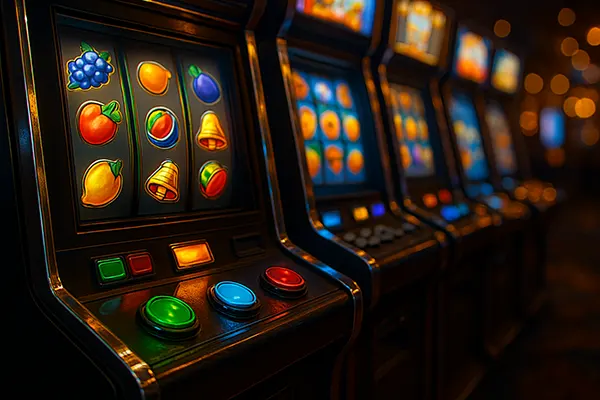
Evolution of Themed Slots: From ‘One-Armed Bandits’ to Story-Driven Sagas
The history of slot machines is a journey that spans over a century, moving from simple mechanical devices to immersive, interactive experiences that blend narrative depth with cutting-edge technology. This transformation reflects broader changes in player preferences, advances in digital gaming, and the integration of storytelling into gambling entertainment. Understanding how themed slots evolved offers insight into how the industry adapted to remain engaging, relevant, and competitive in 2025.
The Mechanical Beginnings and Early Thematic Ideas
The first slot machines, known as “one-armed bandits,” appeared in the late 19th century, relying on mechanical reels and physical levers. Their designs were functional rather than thematic, with symbols like fruits, bells, and card suits dominating the reels. These early games offered straightforward gameplay and minimal graphics, yet they laid the foundation for the concepts of paylines and jackpot rewards that are still central today.
By the mid-20th century, manufacturers began experimenting with light themes, often inspired by popular culture of the time. While these machines still lacked advanced storytelling, they introduced the idea that a slot could offer more than just numbers and generic symbols. Themes like tropical fruits, classic cars, or sports began to emerge, giving machines a unique identity and encouraging repeat play.
The introduction of electromechanical slots in the 1960s allowed for more complex designs, sounds, and limited animations. These developments made it possible to enhance themes visually and audibly, marking the first steps toward immersive experiences. Still, the true thematic revolution would come with the arrival of video slots decades later.
The Shift to Video and Expanding Creative Freedom
The late 1970s and early 1980s marked a pivotal point with the emergence of video slot machines. Using computer screens instead of physical reels, developers gained greater creative freedom to design unique symbols, animated sequences, and varied backgrounds. This shift allowed themes to be more elaborate, from mythology and ancient history to sci-fi and fantasy worlds.
Video slots also introduced bonus rounds, mini-games, and progressive jackpots, which became a perfect complement to storytelling. Players could now progress through different stages, unlock new visuals, and enjoy interactive features that aligned with the chosen theme. This evolution was not only a technological leap but also a psychological one, as players became more emotionally invested in the games.
By the 2000s, licensed themes from movies, television, and music became increasingly common. This crossover between entertainment industries allowed slot developers to tap into existing fan bases while delivering recognisable characters, narratives, and soundtracks within the gaming experience.
The Rise of Story-Driven Slot Experiences
In the 2010s, storytelling became a central element of slot design. Developers moved beyond static themes to create games with evolving plots, character arcs, and cinematic quality visuals. These titles often used episodic structures, with players unlocking new chapters or missions as they played, turning slots into a hybrid of gambling and interactive entertainment.
Advances in 3D graphics, motion capture, and surround sound allowed for more realistic and emotionally engaging experiences. Themes could now include complex historical settings, high fantasy sagas, or crime thrillers, with each spin contributing to the unfolding narrative. This approach attracted a broader audience, including players who valued the entertainment aspect as much as the potential payouts.
Importantly, developers began to focus on cultural diversity in themes, incorporating folklore, traditions, and legends from around the world. This globalisation of thematic content made games appealing to a wider market and showcased the industry’s adaptability to regional tastes.
Integration of Player Choices and Immersive Features
Modern story-driven slots often give players agency through branching narratives or selectable bonus paths. This interactivity enhances replay value, as different decisions can lead to varied story outcomes or rewards. The gameplay becomes more personalised, encouraging longer engagement sessions.
Some developers incorporate RPG-like progression systems, where players level up characters or unlock new story content over time. This blend of gambling mechanics and video game elements creates a unique genre crossover that continues to grow in popularity in 2025.
Additionally, cross-device compatibility ensures that these narrative-rich slots are accessible on desktop, mobile, and tablet devices without losing visual or functional quality. Cloud-based saves allow players to continue their progress seamlessly across platforms, reflecting the modern emphasis on convenience and accessibility.

The Future of Themed Slots Beyond 2025
As technology continues to advance, the future of themed slots lies in deeper immersion and personalisation. Developers are already experimenting with virtual reality (VR) and augmented reality (AR) to create environments players can literally step into. In VR casinos, players may walk through themed worlds, interact with characters, and spin reels in a 360-degree space.
Artificial intelligence is also shaping the future by adapting game difficulty, bonuses, and narrative pacing to individual player behaviour. This ensures that each session feels unique, tailored to the player’s style and preferences. It’s a natural progression from static themes to dynamic, player-responsive storytelling.
Moreover, responsible gambling tools are being seamlessly integrated into thematic designs, offering reminders and controls without breaking immersion. In 2025, this balance between entertainment and responsibility is a defining factor in sustainable slot game development.
Global Trends and Cultural Adaptation
As regulations and player preferences vary worldwide, developers are focusing on culturally sensitive adaptations of popular themes. For instance, certain imagery, symbols, or narratives are modified to align with local norms while retaining the essence of the game’s story. This ensures broader market reach without alienating specific audiences.
Collaborations between developers from different regions are also on the rise, resulting in hybrid themes that blend multiple cultural influences. This not only diversifies content but also fosters innovation in visual and narrative design.
Finally, player communities and social gaming features are becoming integral to themed slots. Leaderboards, shared story progress, and cooperative bonus rounds encourage social interaction, transforming what was once a solitary activity into a shared entertainment experience.
